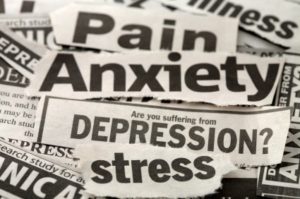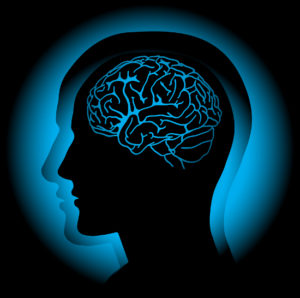Dr. Marylynn Wei writes, “One traditional hypothesis of depression is that people who are depressed have a deficiency in monoamine neurotransmitters in the body, which leads to low levels of neurotransmitters like serotonin and norepinephrine in the brain. But growing evidence supports that at least some forms of depression may also be linked to ongoing low-grade inflammation in the body. Brain imaging of people with depression show that their brain scans have increased neuroinflammation. When your body is in an inflammatory state fighting off the common cold or flu, you can experience symptoms overlapping with depression— disrupted sleep, depressed mood, fatigue, foggy-headedness, and impaired concentration.” Read the rest of her blog.
New Research Shows Depression Linked With Inflammation
Rediscovering Who You Are After a Severe Depressive Episode
Blogger Joy Biddell writes, “But what I’m finding even harder than mundane tasks is rediscovering who I am. Depression stole my identity and my joy. Trying to find myself again while still feeling exhausted, low and riddled with anxiety is one of the hardest things I’ve ever had to do. Everything I knew and enjoyed feels like a distant memory and building myself back up feels like an impossible task. I can’t remember what genuine happiness feels like. I’ve had glimpses of it, but the feeling doesn’t stick around. I can’t remember how to socialize, even texting friends is difficult. I used to enjoy coloring, church, volunteering, reading, driving with tunes blasting and singing at the top of my voice (even in traffic), going out with friends, going for meals out, long walks with the dogs, my partner and seeing family. All these things are incredibly hard to do now. I either can’t remember how to do them, get too anxious and overwhelmed to do them or physically can’t do them.” Read her full blog here.
Diving Into Hell: A Powerful Memoir of Depression
From The New York Times, book reviewer and best-selling author Andrew Solomon writes, “Not so long ago, the mere fact of writing that you had suffered from depression conferred a badge of courage, but such confessions have devolved into a dull mark of solipsistic forthrightness. Famous people use such disclosures to persuade you that they are just like you, perhaps even more vulnerable; it’s a way of compensating for the discomfort attached to their glamor. Indeed, in an increasingly stratified world, people with any modicum of privilege may reveal their depression as an assertion of their common humanity. Clinical misery has taken over from death as the great equalizer. Vanity of vanities, all is depression. Into this morass daringly comes Daphne Merkin with the long-awaited chronicle of her own consuming despair, ‘This Close to Happiness: A Reckoning with Depression.'” Read the entire article here.
3 Practices for Letting Go of Looping Thoughts
Jenna Cho, lawyer and author of the book, “The Anxious Lawyer” writes, “The ability to gently let go of negative looping thoughts has been perhaps one of the most powerful and unexpected benefits of having a regular meditation practice. Research indicates that meditation can help us process and decrease the impact of negative emotions, such as anger. If you find yourself stuck in an endless negative thought loop, here are three practices that you may find useful.” Read the entire blog here.
8 Ways to Persevere When Depression Persists
Therese Borchard blogs, “Although I like to cling to the promise that my depression will get better — since it always has in the past — there are long, painful periods when it seems as though I’m going to have to live with these symptoms forever. In the past, there was a time when I had been struggling with death thoughts for what seemed like forever. The death thoughts did eventually disappear, but I’m always mindful of my depression. Every decision I make in a 24-hour period, from what I eat for breakfast to what time I go to bed, is driven by an effort to protect my mental health.” Read her entire blog here.
Depression: A Psychiatrist’s Recommendations for Self-care
Psychiatrist Monica Starkman, M.D. writes, “In clinical research, one uses the scientific method and studies just one treatment alone in order to assess its effectiveness. But in clinician mode, I am convinced that a combination of effective techniques increases the probability of a strongly positive result – and I don’t really care which of them did the most good. Here are five simple yet powerful treatments I recommend because they are both scientifically valid and clinically effective. Read her entire blog.
Coming to Terms With Depression
In her new memoir, This Close to Happy, Daphne Merkin writes about how she’s made her way through life, not despite, but with depression. She tells NPR’s Scott Simon that sometimes she just has to push herself through bad days. “At really bad times, I will admit I don’t get up,” she says. “I sort of languish, or sleep. But mostly I try and combat it by assertions of will. Which is not the same as saying, ‘Pull yourself up by your bootstraps,’ though … there’s a point at which these assertions of will don’t help. But otherwise, I think there’s a way of negotiating depression, like, talking to it. Saying, ‘you can do this, you’ll be OK, try going outside, try sitting at your desk.’ You know, kind of coaxing oneself.” Listen to the interview here.
Stress and Depression
Survival depends on the speed of noticing and responding to threats to our safety. In a depressed brain, the parts of the brain that are scanning for danger and responding to it are overly active. Perceiving threat comes too easily. There are several factors about this necessary and natural biological response that may contribute to depression.
- The response time is one such factor. Humans are biologically geared to respond to threat with a physical response to it. Without thought or decision, the brain/body makes possible necessary, immediate action when a threat, or stressor, occurs. Regardless of the level of overt danger, when a person feels a threat, the body responds immediately with arousal in the nervous system, intensifying heart rate, respiration rate, and blood pressure to allow for rapid physical activity. This response is proportional to the threat and ends when the threat is gone. A person also gets a release of energy, the activity of the stress response system, needed to fuel the rapid physical activity. These responses are lifesaving when threats to safety occur – but they are also an underlying factor in developing depression when they are overly active. Some people are born with brain structure that commits too many brain cells to scanning for danger, making the threat response too active.
- The intensity of the sympathetic response may be too great, meaning that the level of arousal and the way it triggers stress response is excessive proportional to the threat. This too can be genetic, or it may be an outcome of early childhood adversity causing high arousal to even smaller threats. It is also important to note that traumatic experience often results in hypervigilant attention to the environment and also a biological tendency to overreact to reminders of the trauma.
- Another aspect of how the threat response system can contribute to depression is how hard it may be to calm the stress response or the nervous system arousal. When these two systems that govern response to stressors are insufficiently supplied with the neurochemicals that bring them back to homeostasis or that buffer brain structures from the impact of the arousal, a person may be negatively affected by the very systems that should otherwise be protective. Unable to calm down quickly enough, the strong and persistent arousal of the nervous system and the stress response system is damaging in several ways. One theory of depression is that the inflammation throughout the body will ultimately cause many kinds of physical and emotional outcomes, not the least of which is depression.
The threat in a modern world may not be the overt danger that human systems developed to cope with stress but rather any situation that calls for a response, even when the demand for physical energy is unnecessary. For example, the stressor may be a situation that is not unexpected or dangerous. It could be a boss who makes a demand for overtime hours when you want to be home with your family or a child who is sick and keeping you awake at night. Those may be temporary and insignificant in general, but when they are ongoing or when they are too frequent then the stress system becomes antagonistic to health.
Over-activation of the nervous and stress response systems ultimately exhaust the brain/body. You can help yourself be less affected by stress. A person may, by genetic predisposition, respond too intensely to a normal level of threat or ongoing life stress may exhaust the supply of energy and create distress. Since so many of us live lives that are filled with stressors that are not the life-death-get-up-and-run variety, we would be well advised to learn the means to diminish stress. While each person must apply these guidelines to his or her own situation, the outline is simple:
- If at all possible, eliminate your stressor. Deciding to change is often the hardest thing people do: Can you stop trying to do something that is just too difficult, that you do not have the capacity for? Can you walk away from things that you cannot control and then manage your guilt for not trying? You might need the perspective of an outside observer to help you figure this out.
- Manage your time or manage your environment. Learn to make good use of lists to create job tasks by prioritizing or stop saying yes to demands for your help when you have too much to do. And learn the skills to organize the environment. Trying up may be life-changing indeed for some, but the diminished stress of an orderly environment can be life-saving, especially when you combine it with using calendars, reminders, and lists to manage time.
- Manage your attitude. Lightening up and finding your sense of humor can go a long way toward lowering your stress level. So, can becoming more sanguine about life experience. Learn to tell the difference between what is urgent is important and then learn that urgent may sometimes just be ignored.
- Learn to relax. This is not just about ‘vegging out in front of a program or video game. It is about loosening those muscles and calming the mind. Whether you do best with brief and frequent breaks every day or relax with longer periods of muscle relaxation, either way, it is a relief to your brain/body to relax. People who develop apps know this, so, it turns out there are countless options to use technology to guide your relaxation practice. You may be one of those who relaxes via vigorous exercise. But relax. Daily.
When you have addressed these four means to diminish the intensity of your response to ordinary life stress, then you will be on your way to eliminating depression too.
By Margaret Wehrenberg, Psy.D.
Dr. Wehnrenberg is a coach and therapist, an author, and an international trainer and speaker on topics related to psychotherapy for anxiety and depression, stress management and optimizing anxiety for achievement. She is a practicing psychologist, coaching for anxiety management and providing psychotherapy for anxiety and depression disorders. She has been a trainer of therapists for 25 years, and she is a sought-after speaker for continuing education seminars, consistently getting the highest ratings from participants for her dynamic style and high-quality content. Her individualized coaching for panic, worry and social anxiety has helped professionals from entrepreneurs to corporate executives, from sales personnel to IT specialists.
Margaret is a frequent contributor to the award-winning Psychotherapy Networker magazine and has produced Relaxation for Tension and Worry, an audio file for breathing, muscle relaxation, and imagery to relax. Audio and DVD versions of her training are available for obtaining CEU’s. She has seven books on topics of anxiety and depression published by W.W. Norton, a and a workbook, Stress Solutions, published by PESI. Check out her website MargaretWehrenberg.com.
On Depression, Hope, Hopelessness, and Freedom
Hope is a desire for something combined with an anticipation of it happening, it is the anticipation of something desired. To hope for something is to make a claim about something’s significance to us, and so to make a claim about ourselves.
One opposite of hope is fear, which is the desire for something not to happen combined with an anticipation of it happening. Inherent in every hope is a fear, and in every fear a hope. Other opposites of hope are hopelessness and despair, which is an agitated form of hopelessness.
Hope is often symbolized by harbingers of spring such as the swallow, and there is a saying that ‘there is no life without hope’. Hope is an expression of confidence in life, and the basis for more practical dispositions such as patience, determination, and courage. It provides us not only with aims but also with the motivation to attain those aims. As the theologian, Martin Luther said, ‘Everything that is done in the world is done by hope.’ Hope not only looks to the future but also makes present hardship easier to bear, sustaining us through our winters.
At a deeper level, hope links our present to our past and future, providing us with an overarching narrative that lends shape and meaning to our life. Our hopes are the strands that run through our life, defining our struggles, our successes and setbacks, our strengths and shortcomings, and in some sense ennobling them. Running with this idea, our hopes, though profoundly human—because only humans can project themselves into the distant future—also connect us with something much greater than ourselves, a cosmic life force that moves in us as it does in all of nature. Conversely, hopelessness is both a cause and a symptom of depression, and, in the context of depression, a strong predictor of suicide. “What do you hope for out of life?” is one of my most important questions as a psychiatrist, and if my patient replies “nothing” I have to take that very seriously.
Hope is pleasant in so far as the anticipation of a desire is pleasant. But hope is also painful, because the desired circumstance is not yet at hand, and, moreover, may never be at hand. Whereas realistic or reasonable hopes are more likely to lift us up and move us on, false hopes are more likely to prolong our torment, leading to inevitable frustration, disappointment, and resentment. The pain of harboring hopes, and the greater pain of having them dashed explains why most people tend to be modest in their hoping.
In his essay of 1942, The Myth of Sisyphus, the philosopher Albert Camus compares the human condition to the plight of Sisyphus, a mythological king of Ephyra who was punished for his chronic deceitfulness by being made to repeat forever the same meaningless task of pushing a boulder up a mountain, only to see it roll back down again. Camus concludes, ‘The struggle to the top is itself enough to fill a man’s heart. One must imagine Sisyphus happy.’
Even in a state of utter hopelessness, Sisyphus can still be happy. Indeed, he is happy precisely because he is in a state of utter hopelessness, because in recognizing and accepting the hopelessness of his condition, he at the same time transcends it.
Neel Burton, M.D., is a psychiatrist, philosopher, writer, and wine lover who lives and teaches in Oxford, England. He is a Fellow of Green-Templeton College, Oxford, and the recipient of the Society of Authors’ Richard Asher Prize, the British Medical Association’s Young Authors’ Award, the Medical Journalists’ Association Open Book Award, and a Best in the World Gourmand Award.He is author of Heaven and Hell: The Psychology of the Emotions, Hide and Seek: The Psychology of Self-Deception, and other books.
The Bald-Faced Lies Depression Tells Us
Whatever the cause, clinical depression sufferers are often shackled to a prison of ruminative, negative thoughts about the world and themselves.
They are full of self-loathing, feelings of worthlessness, and a sense of failure. Confidence in their ability to build and maintain successful relationships is eroded. Their sense of competency about their work can plummet as they struggle to get things done, be productive and earn a living. Some may even hate themselves when lost in this destructive process.
If that weren’t tough enough, are brains actually work against in this negative spiral. Psychologist Margaret Wehrenberg writes:
“Brain function plays a role in rumination in several ways, but one significant aspect
Built by Staple Creative













